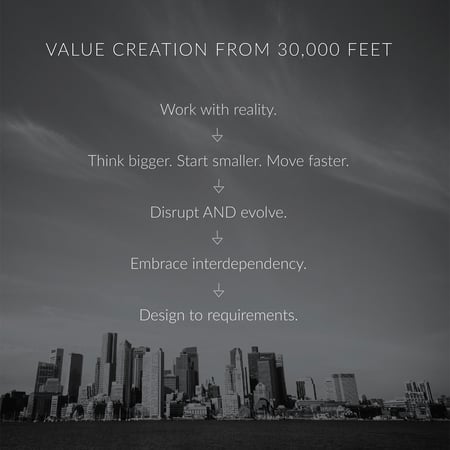Exponential Principles
Today’s revolution is liquidating command-and-control leadership. We see a new paradigm emerging among leaders of insanely great companies: a demand-oriented, “spark-and-speed” way of leading that is characterized by these six organizing principles.
1. Work with reality.
Fighting and resisting what you don’t like about reality only wastes energy. Reality is constantly shifting. Embrace what you have. Look at what is changing and where things are moving from different perspectives. Tune into your trusted colleagues and your “listening posts”. Use change and momentum to do insanely great things.
2. Evolve and disrupt.
Evolution is necessary to keep up with the speed and scope of change happening outside your business. Continuously transform the linear parts of your enterprise, the 70% that you must keep running smoothly to stay in business. While you evolve these linear business parts incrementally, collaboratively and iteratively over time, disrupt parts of your enterprise for the purpose of exponential growth. Recognize that insurgents do not own disruption—and that there is no predicting which disruption will win. Become a challenger to the challengers: disrupt yourself, disrupt them. Or if you can’t disrupt the challengers alone, then collaborate with others who can. For example Hyatt is creating challenger brands to rival Airbnb. They have invested in London-based startup Onefinestay, which rents out Hyatt hotels and the upscale homes of members in London, Paris, New York and Los Angeles.
The odds of me coming into the rocket business, not knowing anything about rockets, not having ever built anything, I mean, I would have to be insane if I thought the odds were in my favor.*
– Elon Musk, Founder, CEO & CTO | SpaceX
3. Make alignment king.
“Us-versus-them” thinking is an artifact of the command-and-control approach that, at best, produces great. At worst, it kills the creative spark and slows work down. Intense alignment has to exist throughout your organization—and across the entire ecosystem of which your company is a part—for acceleration to happen. Orchestrate cooperation and collaboration.
4. Embrace interdependency.
Independency is inefficient and exhausting. Tap into the untapped opportunities that interdependency combined with alignment offer. Generate a bold “we” culture that goes all the way through to the consumer. “We” makes insane possible. As in, we are all in this together. We will not stifle ideas out of fear. We will share our thinking and resources. We will come together so we can disrupt our industry, our competitors, and even ourselves—for the sake of everyone.
5. Be mutually accountable.
Accountability makes coming together a lot more fun. Accountability breeds integrity and transparency. When we can count on each other to deliver, to be there with what’s needed when it’s needed as promised, work flows easily, execution speeds up and trust rises. Not naive trust, but the deep trust and loyalty that develops when people are being rigorously accountable for results. The kind of trust that prompts people to operate as if they “own” the business, the network and the system.
6. Do good.
People want to “do good”—not just make a good living. People want to make life better for themselves and others. In addition to following all of the above principles, declare a bold vision that inspires people to bring their best to work. That is, invent a possible future people want to get behind and to which they willingly will give their all.
We cannot function without leaders. It's up to you… now is the time, this is the place, and you're it. We need you.**
— Warren Bennis
Design & Influence
 A 3.0 CEO skillfully designs their company to keep up with how fast things are changing externally and positively influences people as they ramp up value creation.
A 3.0 CEO skillfully designs their company to keep up with how fast things are changing externally and positively influences people as they ramp up value creation.
You don’t have to be an artistic genius with a large following to succeed at this.
You will, however, want to become what we call a “Master Value Coach” if you want to do good in the world and drive growth today and tomorrow. That is, you will want to become someone who can create the high-level designs and generate the willpower and the energy that will accelerate value creation in your company.
As a CEO, it is your responsibility to look at value from a 30,000-foot level. Fortunately, you already think and act like a designer. You make sense of the world by taking apart what you’re observing and then putting it back together in new ways. You analyze and synthesize, taking both the known and the ambiguous into account. You create a vision in your mind of how to balance opposites simultaneously: improving innovation and efficiency, letting people go and recruiting, saving and spending, managing and leading. You employ divergent and convergent thinking, exploring different possibilities and narrowing down your choices. You are aware that you are not all-seeing and all- knowing. And so you bring what you are noticing to the people who can help you fix any design-level issues in the organization. Those special people you work with to solve the broader, most strategic aspects of the business and the organization. Namely, your leadership team, board members, shareholders, partners, and perhaps even your private equity sponsor (if you have one).
With insights from this collective, you may realize that you have to reposition the company strategically to ride the waves of disruption that are rocking our world. Whether you do reposition or not, you will still have to review what you currently have in place to make sure that what was designed in the past will support—and not hinder—whatever it is you are trying to do with the company to create value in the future.
*Elon Musk. Accessed August 22, 2016 at http://www.brainyquote.com/quotes/quotes/e/elonmusk567218.html.
**Warren Bennis, On Becoming a Leader (Reading, MA: Perseus, 1994), p. 15.
This excerpt is from my new book /grow: The CEO's Master Playbook for Coaching Value into Existence.Now available on Amazon.

